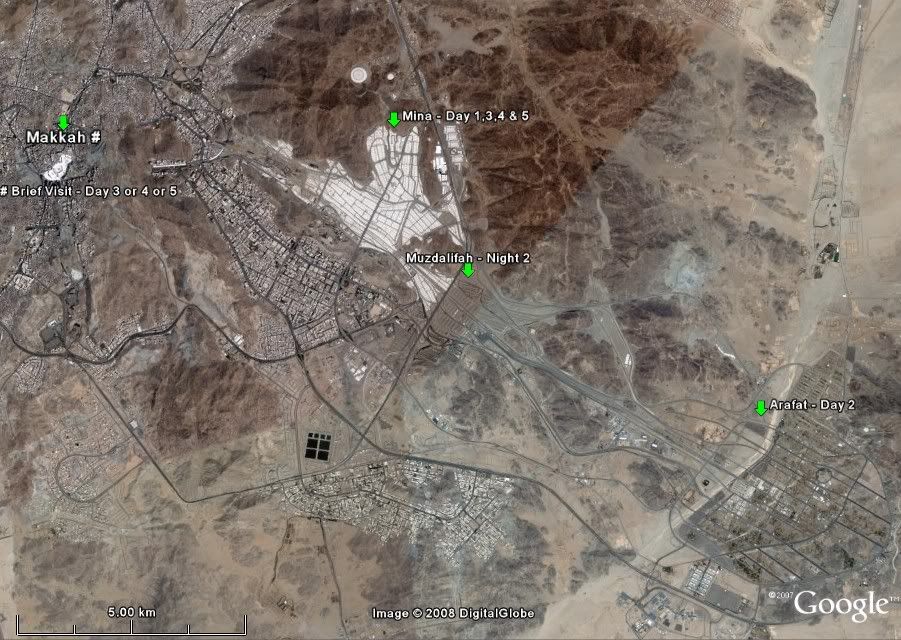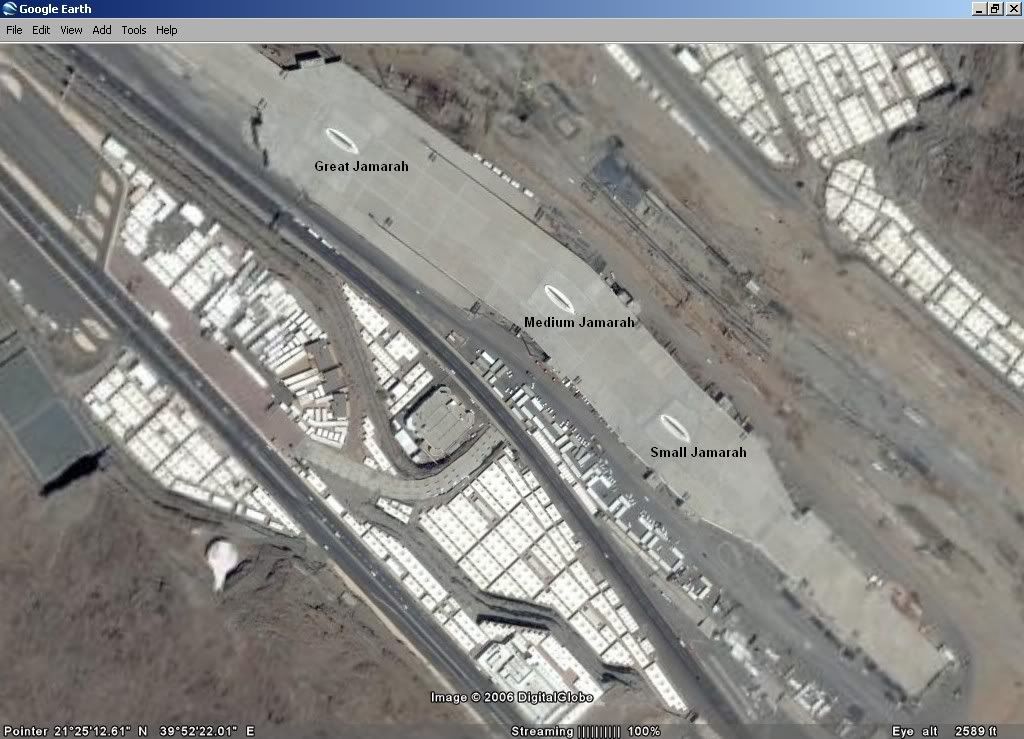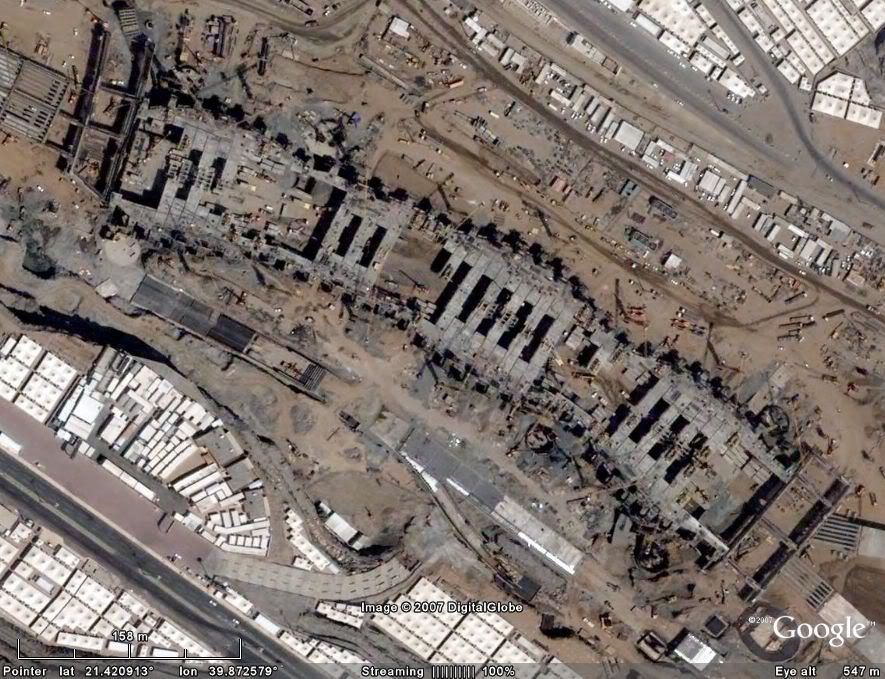Hajj In Google Earth Click Here
Printed From: IslamiCity.org
Category: General
Forum Name: General Discussion
Forum Description: General Discussion
URL: https://www.islamicity.org/forum/forum_posts.asp?TID=15822
Printed Date: 29 November 2024 at 1:40am
Software Version: Web Wiz Forums 12.03 - http://www.webwizforums.com
Topic: Hajj In Google Earth Click Here
Posted By: semar
Subject: Hajj In Google Earth Click Here
Date Posted: 17 November 2009 at 6:51pm
|
http://bbs.keyhole.com/ubb/ubbthreads.php?ubb=showflat&Number=1079046&site_id=1#import - Hajj In Google Earth Click Here
------------- Salam/Peace, Semar "We are people who do not eat until we are hungry and do not eat to our fill." (Prophet Muhammad PBUH) "1/3 of your stomach for food, 1/3 for water, 1/3 for air" |
Replies:
Posted By: semar
Date Posted: 17 November 2009 at 6:52pm
|
Readers to please note - This is not a piece of writing on "How to perform Hajj". This is only a small effort to explain, through images taken from Google Earth and Panoramio, the sequence of the Hajj alongwith locations involved and their importance. Every lunar year in the Islamic month of Dhul-Hijjah (aka Zil-Hajj) millions of Muslims from around the world make the journey to Makkah, Saudi Arabia, for the Hajj pilgrimage. Hajj is one of the five pillars of Islam and every Muslim, except infirm and poor, is required to perform the Hajj once in a lifetime. The Hajj rituals in some form or other were prevalent even in the time of Prophet Muhammad (PBUH) and perhaps trace back to the time of Prophet Ibrahim (Patriarch Abraham). However, Hajj as is performed today, is based on the traditions established by the Prophet Muhammad (PBUH). The Hajj rituals are spread over 5 days starting on the 8th day of the calendar month and are performed at 4 places - Makkah, Mina, Arafat and Muzdalifah, shown in this image from Google Earth.  Day - 1 - Mina On the first day of Hajj all the pilgrims assemble at Mina (aka Muna) in a shallow cup like valley, about 8 kilometres (5 miles) from Makkah. A male pilgrim is required to wear two pieces of unstitched cloth (this is commonly known as Ihram clothe); wrapping himself with one so as to cover himself from the waistline to well below his knees. The other he throws over his shoulders, covering shoulders, his back and chest. The head and face must not be covered at any time. For ladies, their ordinary and unpretentious clothes of daily wear constitute their Ihram but they must cover all their bodies including their head, with the exception of their face and the lower parts of their hands, which must remain uncovered. This simple clothing symbolizes that before Almighty all are equal and there is no difference between the rich and poor. While the pilgrims are in state of Ihram, they cannot shave, cut their nails, use deodorant or perfume. They may not swear or quarrel, kill any living thing (even an insect) or engage in sexual activity. As per tradition the pilgrims stay at Mina in tent, hence Mina is a tent city, catering to a temporary population of about 3 million pilgrims. It is therefore seen in GE view as a large white area.  (Photo taken from http://www.panoramio.com/photo/2521221 - Panoramio is by http://www.panoramio.com/user/155587 - chinx786 )  There is no activity on Day-1, the pilgrims spend their time offering prayers and reading Holy Quran. The stoning of Satan (Devil) also takes place here at Mina but that is on day-3 onwards and will be explained later. After spending first night at Mina, on the second day after performing the prayer at dawn, the pilgrims depart for the plains of Arafat. Day - 2 - Arafat  Arafat (aka Plain of Arafat) is a desert located approximately 14.5 kilometres (9 miles) from Mina. The Mount of Arafat (aka the Mountain of Mercy or Jabal ar-Rahmah in Arabic) is located in the midst of the plain. Prophet Muhammad (PBUH) had delivered his last Hajj sermon from this mount. Arafat is a sandy place and earlier didn't have much greenery. However about 15 years ago massive landscaping efforts were taken and more than 50,000 Neem trees were planted by Saudi authorities. The area is quite green now as can be seen in the in this view from Panoramio as well as in GE view. Mount of Arafat can be seen in he background. The pilgrims stay during the day in temporary tents or under the shade of Neem trees.  (Photo taken from http://www.panoramio.com/photo/1402158 - Panoramio is by http://www.panoramio.com/user/293580 - muhiddin ) For the pilgrims it is the most important day - There is no Hajj without stay at Arafat. If this stay is missed, the whole Hajj is invalidated. The boundary within which the pilgrims must stay at Arafat, are well defined with multi-language markers placed all along the periphery. I have tried to mark the rough boundary in the GE view given above. The afternoon period, couple of hours before Sunset, is considered the most pious time. During this period until sunset, the pilgrims stand in earnest supplication and devotion, praying for God's mercy and forgiveness. It is believed that during this period, The Almighty will be generous to His servants, forgive them for their sins and liberate them from the fire of hell. The scene during this period is emotionally charged and leaves a lasting impression - A multitude of about three millions, praying together, hands upraised with tears in their eyes seeking His forgiveness. As soon as the Sun sets, the pilgrims start leaving for Muzdalifah. Night - 2 - Muzdalifah Muzdalifah is an open area southeast of Mina on the route between Mina and Arafat, about 9 kilometres (6 miles) from Arafat. The pilgrims spend the night here, under the open sky praying. They also collect small pea-sized pebbles here for the stoning of the Satan ritual in Mina during the next three or four days. Day - 3 - Mina On 3rd day at Muzdalifah the pilgrims offer prayers at the dawn of the day and then just before sunrise start the return journey to the tent city. Since Mina is now only about 5 kilometres (3 miles) away many pilgrims prefer to walk instead of taking bus. On reaching the Mina, the pilgrims proceed to Jamarat Bridge for stoning of Satan. Women, sick men and elderly persons are excused from this ritual and can authorize some one else to do the pelting on their behalf. The stoning symbolizes the dilemma experienced by Prophet Ibrahim, whether or not to sacrifice his son Ishmael (Ismail) as per the Divine vision. The Satan had appeared three times to divert Prophet Ibrahim's mind from his goal but each time Prophet Ibrahim drove him away by pelting with stones. Till a few decades back there were three pillars (Arabic: jamarat), each pillar marking the location where Prophet Ibrahim drove away the Satan. The word jamarat is plural of jamarah meaning pillar. The eastern most is known as small jamarah, the central one the medium jamarah and the last is known as great jamarah. Since every pilgrim is required to hit each pillar at least seven times and the space was very limited, this place was scene of many stampedes and tragic deaths. In mid sixties a two tiered bridge was made here with three conical openings. The pilgrims could throw the pebbles either from the ground floor or from the upper floor through the openings. One such pillar and the opening can be seen in the photo below;  (Photo taken from http://www.panoramio.com/photo/270887 - Panoramio is by http://www.panoramio.com/user/55626 - Aymen ) Here is an earlier GE image in which the three openings can be seen.  After the tragic incidence of 2004, in which about 250 pilgrims were killed and many pilgrims were injured, the 2 tiered bridge was demolished and a new 5 storey bridge has been constructed. The pillars have also been replaced by longer and taller oblong walls so as to allow larger crowd to do the pelting at a time.  (Photo taken from http://www.panoramio.com/photo/976323 - Panoramio is by http://www.panoramio.com/user/155587 - chinx786 ) Here is GE image of bridge as it looks in last (January 2007) imagery update of GE.  Not much can be seen in this GE view because of ongoing constructional activity. It is however understood that now the entire 5 storey are ready for the current (Dec 2007) Hajj. Another 4 storey are also proposed to be added in few years time. On this day only the last pillar, representing great Satan is stoned. After pelting (known as Ramy in Arabic), the pilgrims are required to carry out sacrificial slaughter (Qurbani) of atleast an animal (sheep, cow, camel etc.) and give away the meat to the poor. This symbolizes and in a way enacts Prophet Ibrahim's willingness to sacrifice his son. Pilgrim can authorise another person or agent (local bank/their travel agency etc.) to carry out this sacrificial slaughter on their behalf. Each year, over a million animals are sacrificed, in modern abattoirs. In order to avoid wastage of meat, the surplus is packaged and then distributed internationally to persons/countries in need/distress. Once the sacrifice is over or a confirmation is received from the authorised agent that sacrifice has been carried out, the male pilgrims shave their head while the women trim a small part of their hair. The pilgrims are now free from all Ihram restrictions except marital relations, which will remain in force till they go to Makkah and return. They change into normal clothes, congratulate each other and rejoice. The sacrificing of animals is spread over three days (day 3, 4 or 5 of Hajj) but one cannot come out of Ihram restrictions and clothing till sacrifice takes place. In the next step of Hajj, the pilgrims are required to go to Makkah for Tawaf - circumambulation around Holy Kaaba seven times and Sai - walking to and fro seven times between the hillocks of Safa and Marwa. This trip to Makkah is another important part of Hajj and it can be either on 3rd day or 4th or 5th day but only after the animal sacrifice. Makkah and then back to Mina Makkah is only 8 kilometres (5 miles) from Mina so many persons walk the distance and Saudi authorities have built tunnels and special roads for pedestrians. These tunnels can be easily seen in GE view. The Holy Kaaba The Kaaba (derivation of Arabic word muka'ab meaning cube) is a large cubical building. It is the holiest place in Islam and is the direction (Qibla) Muslims, all around the world, face during prayers. The original Kaaba was built by Prophet Ibrahim and his son. The Mosque which is built around the Kaaba is known as al-Masjid al-Haram. (Masjid = Mosque, Haram = Sanctuary or Holy site).  After reaching Makkah and prior to starting the circumambulation around Holy Kaaba, the pilgrims offer a small prayer preferably near a spot called "The Station of Abraham" (Arabic: Al Maqame Ibrahim). It is a golden cage containing a stone pedestal on which Prophet Ibrahim stood while constructing the Kaaba. It is located about few metres away from the North-East face of Kaaba. Being small in size it is not identifiable in GE view. I have tried to point to the likely spot. Due to huge crowd most of the time it is not possible to offer this prayer near the spot so it is permitted to offer any where within the precincts of Holy Mosque. The Station of Abraham (golden cage) can be seen at the extreme right edge of this photograph.  (Photo taken from http://www.panoramio.com/photo/751272 - Panoramio is by http://www.panoramio.com/user/155587 - chinx786 ) Here is close-up image of the stone pedestal inside the golden cage of Station of Abraham.  (Photo taken from http://www.panoramio.com/photo/4690586 - Panoramio is by http://www.panoramio.com/user/155587 - chinx786 ). The pilgrims now perform the circumambulation (known as Tawaf Ziyarah or Tawaf al-Ifadha or Tawaf al-Hajj) by taking seven anti-clockwise rounds of Holy Kaaba, starting from the eastern corner where the Sacred Black Stone is embedded. A green line is also marked on the floor to indicate the starting point. Full seven rounds can take anywhere from 20-25 minutes to couple of hours depending how far is one's distance from the Kaaba. During peak time many pilgrims have no choice but to take round trip at the outer periphery of the Holy Mosque. The circumambulation can also be done on the first floor or on the roof of the Holy Mosque as can be seen from this photo.  (Photo taken from http://www.panoramio.com/photo/4256464 - Panoramio is by http://www.panoramio.com/user/155587 - chinx786 ) After completing the seven rounds of Kaaba the pilgrims now take seven, to and fro trips between two hillocks (Safa and Marwah) near the Kaaba. These hillocks about 450 metres apart, are now enclosed within the Holy Mosque's complex. This back and forth travel is called Sai and is done in remembrance of the plight of Prophet Ibrahim's wife Hagira (Hagar), who frantically searched in the area for water for her infant son Ismail (Ishmael), when they were left alone in the desert by Prophet Ibrahim as consequence of a Divine vision. While searching for water a spring had sprouted in the desert. This ancient spring, known as ZamZam, continues to flow today and is considered holy by Muslims. The to and fro circuit used to be in the open air, but is now an entirely enclosed air-conditioned double storey corridor within the Holy Mosque. It can be easily seen in the GE view. As part of this ritual, the pilgrims also drink water from the holy Zamzam Well which, being situated in the basement of The Holy Mosque cannot be seen in GE view. After completing of these rituals the pilgrims have to now return back to their tents in Mina and stay there till day -5. Day - 4 - Mina The only activity on this day is Ramy (pelting of the Satan with stones). Unlike earlier pelting, this time all the three jamarah (pillars symbolising the Satan) are to be pelted. First the small then the medium and lastly the great jamarah. Thereafter there is no other activity and pilgrims rest and pray in their tents. Those who coudn't go to Makkah on day-3 for circumambulation ritual, go on this day to Makkah but then again must return back to spend night at Mina. Day - 5 - Mina Like the day-4 the only activity on this day is pelting of the stones on all the three jamarah and then on completion of the pelting the pilgrims return to Makkah. However if any pilgrim is unable to leave Mina by sunset then he is required to stay at Mina for one more night and perform an additional round of pelting again on day-6 before he returns to Makkah. With this the Hajj ritual is completed. It is pertinent to note that the simultaneous multi-location movement and control of Three million pilgrims is an enormous logistical and transportation task. Although Saudi authorities have built large networks of roads and several other infrastructures but still some glitches/mishaps do happen, but on the whole the entire Hajj is performed smoothly without trouble. Note: Photos provided by http://www.panoramio.com/ - Panoramio are under the copyright of their owners. ------------- Salam/Peace, Semar "We are people who do not eat until we are hungry and do not eat to our fill." (Prophet Muhammad PBUH) "1/3 of your stomach for food, 1/3 for water, 1/3 for air" |